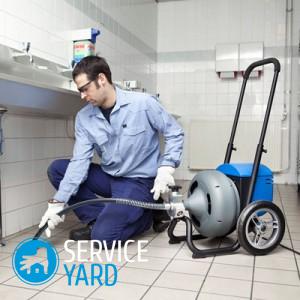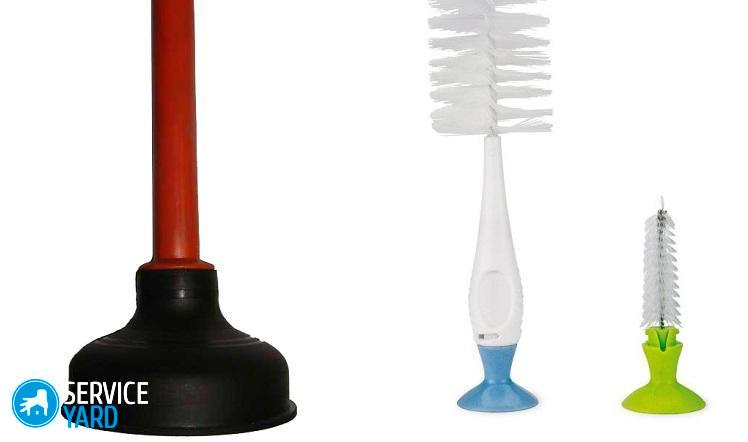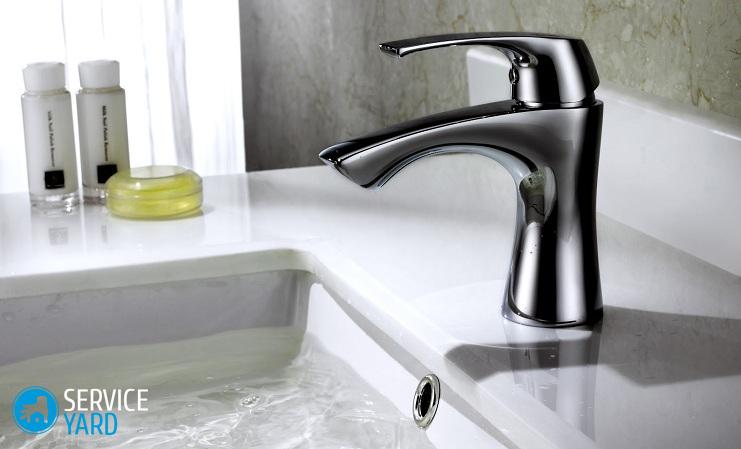How to break a blockage in a pipe at home?

Each owner sooner or later faces the problem of clogged pipes in the apartment. Sometimes you can’t do without a professional plumber, but in most cases it is easy to find a way to break the blockage in the pipe at home yourself. Even if no special tools are available. The need to clean the sewer pipes is indicated by a decrease in the speed of the water leaving the drain, as well as the presence of an unpleasant odor that comes from the sink in the kitchen or in the bathroom. We will understand why this problem arises with one or another periodicity, what to do in this case.
to contents ↑Causes of blockage in the pipes:
- In the houses of old buildings there are still sewer pipes made of cast iron. This material is subject to corrosion, which is why over time the internal walls become uneven, rust deposits on them.
Important! Often a blockage is formed in precisely such potentially dangerous places: the interval from the outlet of the sink in the kitchen to the outlet in the bathroom.
- If the house has sewer pipes made of plastic, then the reason for the blockage can be their incorrect installation, that is, non-observance of the slope of the pipe towards the riser, which invariably leads to the formation of plaque inside the pipes.
- One of the most common causes of clogging in pipes is fat. Over time, it settles inside the pipes, retains food debris and small debris - such a precipitate gradually compacts and significantly reduces the throughput of the pipe.
to contents ↑Important! Most often, pipes become clogged in the summer-autumn period, when the volume of consumed water increases, and with it the amount of garbage that enters the sewer. Particular attention should be paid to the period when harvesting for the winter occurs - at this time it is advisable to have something on hand with which to clean the pipes.
How to clean the blockage in the pipes: the necessary tools and facilities
Understanding the question of how to remove blockage in the pipe at home, we list the methods and devices that are useful to us for this.
Mechanical methods:
- The easiest option is to use a conventional plunger. This tool is in almost every home. With it, you can easily cope with a simple blockage, for example, if the sink is clogged with small particles of garbage, dirt or grease.
- More difficult blockages for the plunger are not within the power, here you will have to turn to the help of more serious methods. In such cases, use a three-meter plumbing cable with a spike at the end. However, please note that the cable is not suitable for brass, chrome and plastic siphons.
Important! Also, for effective pipe cleaning, you can resort to the help of a ruff and wire.
Chemical methods
How to clean a blockage in pipes using chemicals? Very simple - buy a pipe cleaner in any hardware store and follow the instructions on the packaging.
 Typically, the product is poured into the sink, wait about 30 minutes and rinse with plenty of hot water.
Typically, the product is poured into the sink, wait about 30 minutes and rinse with plenty of hot water.
Important! It can be powders, alkalis, liquids, acids or gels (“Silite”, “Tyreth”, “Mr. Muscle”, “Mole”).
Sodium hydroxide is present in the composition of these products - it is thanks to it that the purification takes place.
The principle of action of chemicals is to “corrode” accumulations on the inner walls of pipes. Using these tools, you can not worry about the safety of sewer systems made of cast iron and plastic.
Using chemical cleaners, some rules must be observed:
- On hands you need to wear rubber gloves;
- Face should be covered with a protective mask.
to contents ↑Important! It is advisable to use chemicals to clean the pipes at least once for 2-3 months, then you will be able to avoid replacing the expensive sewage system for a long time.
How to clean the pipes in the bathroom?
The sink in the bathroom, unlike the kitchen sink, is usually equipped with a safety drain hole. Therefore, before you start cleaning, it must be closed.
Method 1
With the help of a plunger, a hydraulic shock is formed, due to which the accumulation of dirt is displaced down the pipe from the narrowest place of discharge, where a blockage usually forms.
Eliminate the blockage:
- First you should fill the bathtub with water so that the cup of the plunger is completely covered.
- Install the plunger over the drain hole, pressing it well against the hole, and then sharply press the handle several times and sharply pull the plunger out of the water.
- This procedure can be repeated until the water begins to pass freely.
Important! To ensure a better fit of the plunger, you can lubricate its edges with an inexpensive cream.
Method 2
You can also clean the bath with a ruff - you need to enter it into the sewer hole and break through the resulting blockage with sudden movements.
Important! If necessary, the ruff can be attached to a flexible rod - the resulting elongated structure can get a blockage at great depths.
Method 3:
- If you intend to use a plumbing cable for cleaning, first you need to unscrew the siphon, and then insert it into the drain hole as deep as possible. By screwing into the pipe, the cable cleans all the blockages, so that the garbage moves along the drain and is washed out.
- After the drain is cleaned, it is necessary to rinse all the elements of the drain channel and clean the siphon.
to contents ↑Important! If suddenly you don’t have a cable or wire at hand, use an electric drill and a screwdriver with which you can also effectively deal with clogging.
We clean the pipes from clogging in the kitchen
Now I would like to talk about how to clean the blockage in the pipes of the kitchen sink yourself. First you need to understand how the sink siphon works, because in many cases you can limit yourself to just cleaning it.
Bottle siphon
The most common are bottle siphons, the diameter of which is 32 or 40 mm. The smaller the diameter, the faster the drain hole becomes clogged.
The siphon design provides for a removable part that resembles a bottle bottom. Removing a blockage in the sink with such a siphon is not difficult at all, since no special tools are needed to unscrew the removable part.
So:
- Unscrew and remove the sump by first placing a bucket or a bowl under it so that the remaining water does not spill onto the floor.
- Clean the siphon with a hooked wire.
Pipe siphon
Also, other types of siphons can be installed in kitchen sinks, for example, pipe siphons - they are made in the form of a curved tube. Often there are easily bent corrugated siphons - they are installed in non-standard conditions.
Important! If a washing machine or dishwasher is connected, double or triple siphons are installed.
To prevent clogging of the sink in the kitchen, you can put a plastic mesh on the drain hole - this is a simpler and cheaper way. And you can install a special meat grinder, which effectively grinds all the waste that got into the sink.Such a device will save you from the need to often clean the pipes - it copes well not only with soft waste, but is also able to grind bones, while working silently.
to contents ↑Folk ways
In order to eliminate clogging in the pipe at home, you can resort to folk methods.
Option 1
Here soda and vinegar are useful to us, since these are the most affordable and cheapest products that any housewife can use without the help of a plumber:
- It is necessary to take vinegar and soda in equal proportions, for example, one glass each.
- Soda is poured into the drain hole, and vinegar is poured on top.
- Then the hole is corked and left for 2-3 hours.
- After the specified time, the pipe is washed with hot water.
Important! This method of cleaning is the simplest and cheapest, while absolutely safe for pipes. It can be used not only to remove blockage, but also as a preventative measure.
Option 2
For the second method of clearing blockages:
- Take about 150 g of soda and thoroughly bake it in a cast-iron skillet (about 15 minutes).
- After complete cooling, dilute the soda with a glass of water and mix thoroughly.
Important! This composition can be compared with the well-known store tool for cleaning pipes “Mole”.
Option 3
Another effective and safe way to clean the pipes is to use a lemon. For this:
- Take a few large lemons and squeeze their juice directly into the drain hole.
- If there are no lemons, you can take half a cup of lemon juice concentrate.
Important! Simple clogging of the sink can be removed with a powerful vacuum cleaner using the blowing mode.
Option 4
If clogging occurs from fat plugs, prepare a strong salt solution. Then fill it into the drain hole and clean the drain with a plunger.
to contents ↑How to clean the blockage in the pipes so as not to spoil them?
It must be remembered that using chemicals to clean the blockages in the pipes can cause considerable harm to plumbing equipment. The fact is that some chemical reactions occur with the release of a large amount of heat. Therefore, bending over the sink and looking into the drain hole is strictly prohibited.
Also, see the instructions for restrictions on certain pipe materials, as some designs may not withstand the effects of too active reagents.
It is necessary to choose chemicals for cleaning, taking into account the type of pollution and the material of the water supply. Usually, the universal remedy “Mole” is suitable, which copes with various kinds of pollution.
to contents ↑Important! A plumbing cable can be used to clean pipes made of metal, but plastic pipes can be damaged - they must be cleaned with extreme care.
Stock footage
Plastic itself is not subject to corrosion, and dirt adheres to its surface rather poorly. But over time, the fat still clogs the drains and when it becomes necessary to remove the blockage, it is better to use a plunger or chemicals. And the rest, you are now fully armed to solve any problems with sewers.
- How to choose a vacuum cleaner taking into account the characteristics of the house and coatings?
- What to look for when choosing a water delivery
- How to quickly create comfort at home - tips for housewives
- How to choose the perfect TV - useful tips
- What to look for when choosing blinds
- What should be running shoes?
- What useful things can you buy in a hardware store
- Iphone 11 pro max review
- Than iPhone is better than Android smartphones





